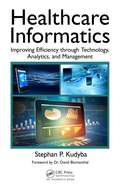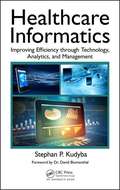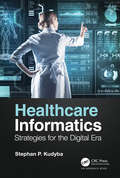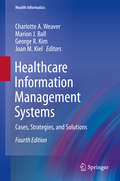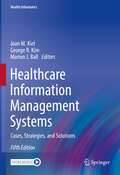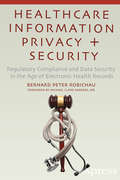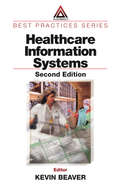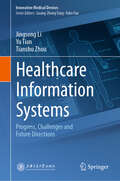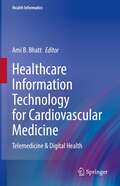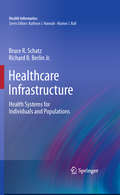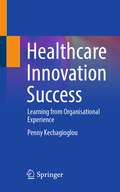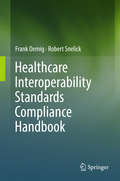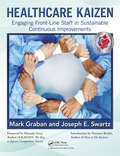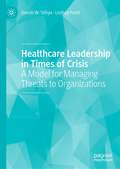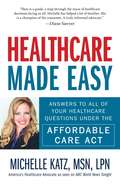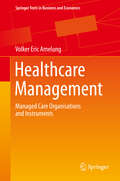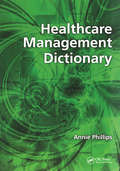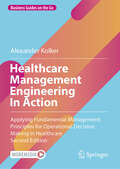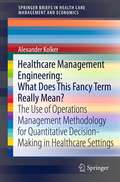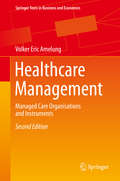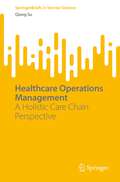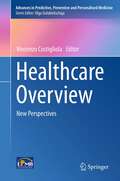- Table View
- List View
Healthcare Informatics: Improving Efficiency through Technology, Analytics, and Management
by Stephan P. KudybaHealthcare Informatics: Improving Efficiency through Technology, Analytics, and Management supplies an understanding of the different types of healthcare service providers, corresponding information technologies, analytic methods, and data issues that play a vital role in transforming the healthcare industry. All of these elements are reshaping the various activities such as workflow and processes of hospitals, healthcare systems, ACOs, and patient analytics, including hot spotting, risk stratification, and treatment effectiveness.A follow-up to Healthcare Informatics: Improving Efficiency and Productivity, this latest book includes new content that examines the evolution of Big Data and how it is revolutionizing the healthcare industry. It presents strategies for achieving national goals for the meaningful use of health information technology and includes sound project management principles and case illustrations for technology roll-out, such as Computer Physician Order Entry (CPOE) for optimal utilization.The book describes how to enhance process efficiency by linking technologies, data, and analytics with strategic initiatives to achieve success. It explains how to leverage data resources with analytics to enhance decision support for care providers through in-depth descriptions of the array of analytic methods that are used to create actionable information, including Business Intelligence, Six Sigma, Data, and Text Mining.
Healthcare Informatics: Improving Efficiency through Technology, Analytics, and Management (2nd Edition)
by Stephan P. KudybaHealthcare Informatics: Improving Efficiency through Technology, Analytics, and Management supplies an understanding of the different types of healthcare service providers, corresponding information technologies, analytic methods, and data issues that play a vital role in transforming the healthcare industry. All of these elements are reshaping the various activities such as workflow and processes of hospitals, healthcare systems, ACOs, and patient analytics, including hot spotting, risk stratification, and treatment effectiveness.
Healthcare Informatics: Strategies for the Digital Era
by Stephan P. Kudyba"This book addresses how health apps, in-home measurement devices, telemedicine, data mining, and artificial intelligence and smart medical algorithms are all enabled by the transition to a digital health infrastructure…..it provides a comprehensive background with which to understand what is happening in healthcare informatics and why."—C. William Hanson, III, MD, Chief Medical Information Officer and Vice President, University of Pennsylvania Health System. "This book is dedicated to the frontline healthcare workers, who through their courage and honor to their profession, helped maintain a reliable service to the population at large, during a chaotic time. These individuals withstood fear and engaged massive uncertainty and risk to perform their duties of providing care to those in need at a time of crisis. May the world never forget the COVID-19 pandemic and the courage of our healthcare workers".—Stephan P. Kudyba, Author Healthcare Informatics: Evolving Strategies in the Digital Era focuses on the services, technologies, and processes that are evolving in the healthcare industry. It begins with an introduction to the factors that are driving the digital age as it relates to the healthcare sector and then covers strategic topics such as risk management, project management, and knowledge management that are essential for successful digital initiatives. It delves into facets of the digital economy and how healthcare is adapting to the geographic, demographic, and physical needs of the population and highlights the emergence and importance of apps and telehealth. It also provides a high-level approach to managing pandemics by applying the various elements of the digital ecosystem. The book covers such technologies as: Computerized physician order entry (CPOE) Clinical Information Systems Alerting systems and medical sensors Electronic healthcare records (EHRs) Mobile healthcare and telehealth. Apps Business Intelligence and Decision Support Analytics Digital outreach to the population Artificial Intelligence The book then closes the loop on the efficiency enhancing process with a focus on utilizing analytics for problem solving for a variety of healthcare processes including the pharmaceutical sector. Finally, the book ends with current and futuristic views on evolving applications of AI throughout the industry.
Healthcare Information Management Systems
by Marion J. Ball Charlotte A. Weaver George R. Kim Joan M. KielHealthcare Information Management Systems, 4th edition, is a comprehensive volume addressing the technical, organizational and management issues confronted by healthcare professionals in the selection, implementation and management of healthcare information systems. With contributions from experts in the field, this book focuses on topics such as strategic planning, turning a plan into reality, implementation, patient-centered technologies, privacy, the new culture of patient safety and the future of technologies in progress. With the addition of many new chapters, the 4th Edition is also richly peppered with case studies of implementation. The case studies are evidence that information technology can be implemented efficiently to yield results, yet they do not overlook pitfalls, hurdles, and other challenges that are encountered. Designed for use by physicians, nurses, nursing and medical directors, department heads, CEOs, CFOs, CIOs, COOs, and healthcare informaticians, the book aims to be a indispensible reference.
Healthcare Information Management Systems: Cases, Strategies, and Solutions (Health Informatics)
by Marion J. Ball George R. Kim Joan M. KielThis new edition of the classic textbook provides bold and honest descriptions of the current and evolving state of US healthcare information technology. Emerging technologies and novel practice and business models are changing the delivery and management of healthcare, as innovation and adoption meet new needs and challenges, such as those posed by the recent COVID-19 pandemic. Many facets of these are presented in this volume:• The increasing mutual impact of information technology and healthcare with respect to costs, workforce training and leadership• The changing state of healthcare IT privacy, security, interoperability and data sharing through health information exchange• The rise and growing importance of telehealth/telemedicine in the era of COVID-19• Innovations and trends in the development and deployment of health IT in public health, disease modeling and tracking, and clinical/population health research• Current work in health IT as it is used in patient safety, chronic disease management, critical care, rehabilitation/long-term/home-based patient care and care coordination• “Brave new world” visions of healthcare and health IT, with forward- looking considerations of the impact of artificial intelligence, machine learning on healthcare equity and policyBuilding on the success of previous editions, this 5th edition of Healthcare Information Management Systems: Cases, Strategies, and Solutions provides healthcare professionals insights to new frontiers and to the directions being taken in the technical, organizational, business and management aspects of information technology in the ongoing quest to optimize healthcare quality and cost, and to improve universal health at all levels.
Healthcare Information Privacy and Security
by Bernard Peter RobichauHealthcare IT is the growth industry right now, and the need for guidance in regard to privacy and security is huge. Why? With new federal incentives and penalties tied to the HITECH Act, HIPAA, and the implementation of Electronic Health Record (EHR) systems, medical practices and healthcare systems are implementing new software at breakneck speed. Yet privacy and security considerations are often an afterthought, putting healthcare organizations at risk of fines and damage to their reputations. Healthcare Information Privacy and Security: Regulatory Compliance and Data Security in the Age of Electronic Health Records outlines the new regulatory regime, and it also provides IT professionals with the processes and protocols, standards, and governance tools they need to maintain a secure and legal environment for data and records. It's a concrete resource that will help you understand the issues affecting the law and regulatory compliance, privacy, and security in the enterprise. As healthcare IT security expert Bernard Peter Robichau II shows, the success of a privacy and security initiative lies not just in proper planning but also in identifying who will own the implementation and maintain technologies and processes. From executive sponsors to system analysts and administrators, a properly designed security program requires that that the right people are assigned to the right tasks and have the tools they need. Robichau explains how to design and implement that program with an eye toward long-term success. Putting processes and systems in place is, of course, only the start. Robichau also shows how to manage your security program and maintain operational support including ongoing maintenance and policy updates. (Because regulations never sleep ) This book will help you devise solutions that include: Identity and access management systems Proper application design Physical and environmental safeguards Systemwide and client-based security configurations Safeguards for patient data Training and auditing procedures Governance and policy administration Healthcare Information Privacy and Security is the definitive guide to help you through the process of maintaining privacy and security in the healthcare industry. It will help you keep health information safe, and it will help keep your organizationwhether local clinic or major hospital systemon the right side of the law. What you'll learn The basics ofHITECH, HIPAA, and other federal laws driving change in healthcare IT How to identify the core issues of privacy and security in a healthcare environment. The steps required to develop and execute a security project plan. The technologies and tools available to aid in the process of deploying a secure EHR system. The core regulatory issues and practical matters of security in a healthcare environment. The frameworks and methodology that will assist in tackling the issues of privacy and security. The technologies impacted by matters of privacy and security along with proposals for managing them effectively. Who this book is for Healthcare professionals who work in information technology, information security, health information management, as well as in the more specialized areas of privacy, compliance, and informatics. The book is also useful for consultants working in the field of information security who require a better understanding of the challenges facing the healthcare industry, EMR Vendors who are tasked with guiding their customers through a secure implementation of their product, and technology professionals seeking to make an entry into the world of Healthcare IT. Table of ContentsChapter 1. Introduction: The Long-Awaited Manual Chapter 2. Waking the Sleeping Giant: A Brief History of Healthcare ITChapter 3. It's Not Just HIPAA: Legislating Privacy and SecurityChapter 4. Assembling the Team: Bringing the Right Human Resources to the TableChapter 5. Sifting Through the Wreckage: The Security Audit C
Healthcare Information Systems
by Kevin BeaverThe move to manage medicine from a financial perspective, i.e. managed care, has added huge layers of bureaucratic and administrative functions to healthcare. The need to have the ability to track patient medical records, mandated by government legislation such as HIPAA, is bringing new technologies and processes into the healthcare arena. A univer
Healthcare Information Systems: Progress, Challenges and Future Directions (Innovative Medical Devices)
by Yu Tian Jingsong Li Tianshu ZhouThis book comprehensively and systematically introduces the latest research progress, challenges, and future directions of various healthcare information systems. Starting from the formation, development, and typical research achievements of medical informatics, the book provides a detailed overview of the more mature healthcare information systems, including electronic medical record systems, laboratory information systems, picture archiving and communication systems, clinical decision support systems, Internet of medical things systems, telemedicine systems and mobile health systems, etc. Additionally, it delves into the rapid evolution of the Internet hospital, proactive health systems, and intelligent systems for medical and elderly-care combination in the era of big data, focusing on the fundamentals of big data technology and the transformation of medical informatization. This book can serve as a reference for researchers or engineers with a certain professional background engaged in cutting-edge research related to medical and health information systems, as well as a teaching reference for graduate or undergraduate students in related fields.
Healthcare Information Technology for Cardiovascular Medicine: Telemedicine & Digital Health (Health Informatics)
by Ami B. BhattThis unique book comprehensively reviews how information technology is changing cardiovascular medical practice. Chapters include a wide range of topics from specific technologies and virtual care education to large system implementation. Extensive illustrative material and specific case studies are included throughout to reinforce key concepts and enable the reader to develop an understanding of how information technology is impacting medical practice. Health equity, medicolegal ethics, and regulatory considerations are also covered. Healthcare Information Technology for Cardiovascular Medicine: Telemedicine & Digital Health provides a foundation for better understanding how these technologies impact cardiovascular care delivery. Its comprehensive analysis enables healthcare providers and other stakeholders to enhance clinical practice through digital health implementation.
Healthcare Infrastructure
by Richard B. Berlin Jr. Bruce R. SchatzThe first systematic survey of Healthcare Infrastructure, this book describes the inevitable future of health systems. It gives a concrete plan for improved quality at diminished cost, via merger of personal medicine and public health. It discusses general aspects of infrastructure engineering and specific aspects of healthcare systems. It discusses current and future technologies for health measurement and management. This book outlines how the health of populations will be measured at the level of individuals, combining engineering and medicine to support viable health systems for the first time. This book is unique, in combining a systematic survey of health determinants with a research monograph on health technologies. Readers will gain a broad context and a deep knowledge of future information technology applied to health systems.
Healthcare Innovation Success: Learning from Organisational Experience
by Penny KechagioglouThe role of leadership in driving innovation through its different stages is fully explored in this book to enable clinical leaders and managers to design innovation frameworks. The book highlights how to maximize the benefits of innovation for organizations and integrated care systems while acknowledging that the process of innovation within healthcare organizations can be complex and needs to be well orchestrated to enable innovation to spread and sustain. The book examines the leadership enablers in healthcare innovation highlighting a new and refreshing strategic model of innovation. The model is used as the foundation to support the process of innovation, from ideation to implementation, within contemporary and ambitious healthcare organizations.
Healthcare Interoperability Standards Compliance Handbook
by Frank Oemig Robert SnelickThis book focuses on the development and use of interoperability standards related to healthcare information technology (HIT) and provides in-depth discussion of the associated essential aspects. The book explains the principles of conformance, examining how to improve the content of healthcare data exchange standards (including HL7 v2. x, V3/CDA, FHIR, CTS2, DICOM, EDIFACT, and ebXML), the rigor of conformance testing, and the interoperability capabilities of healthcare applications for the benefit of healthcare professionals who use HIT, developers of HIT applications, and healthcare consumers who aspire to be recipients of safe and effective health services facilitated through meaningful use of well-designed HIT. Readers will understand the common terms interoperability, conformance, compliance and compatibility, and be prepared to design and implement their own complex interoperable healthcare information system. Chapters address the practical aspects of the subject matter to enable application of previously theoretical concepts. The book provides real-world, concrete examples to explain how to apply the information, and includes many diagrams to illustrate relationships of entities and concepts described in the text. Designed for professionals and practitioners, this book is appropriate for implementers and developers of HIT, technical staff of information technology vendors participating in the development of standards and profiling initiatives, informatics professionals who design conformance testing tools, staff of information technology departments in healthcare institutions, and experts involved in standards development. Healthcare providers and leadership of provider organizations seeking a better understanding of conformance, interoperability, and IT certification processes will benefit from this book, as will students studying healthcare information technology.
Healthcare Kaizen: Engaging Front-Line Staff in Sustainable Continuous Improvements
by Mark Graban Joseph E. SwartzHealthcare Kaizen focuses on the principles and methods of daily continuous improvement, or Kaizen, for healthcare professionals and organizations. Kaizen is a Japanese word that means "change for the better," as popularized by Masaaki Imai in his 1986 book Kaizen: The Key to Japan‘s Competitive Success and through the books of Norman Bodek, both o
Healthcare Kaizen: Engaging Front-Line Staff in Sustainable Continuous Improvements
by Mark Graban Joseph E. SwartzHealthcare Kaizen focuses on the principles and methods of daily continuous improvement, or Kaizen, for healthcare professionals and organizations. Kaizen is a Japanese word that means "change for the better," as popularized by Masaaki Imai in his 1986 book Kaizen: The Key to Japan‘s Competitive Success and through the books of Norman Bodek, both of whom contributed introductory material for this book.Winner of a 2013 Shingo Research and Professional Publication Award!In 1989, Dr. Donald M. Berwick, founder of the Institute for Healthcare Improvement and former administrator of the Centers for Medicare & Medicaid Services, endorsed the principles of Kaizen in the New England Journal of Medicine, describing it as "the continuous search for opportunities for all processes to get better." This book shows how to make this goal a reality.Healthcare Kaizen shares some of the methods used by numerous hospitals around the world, including Franciscan St. Francis Health, where co-author Joe Swartz has led these efforts. Most importantly, the book covers the management mindsets and philosophies required to make Kaizen work effectively in a hospital department or as an organization-wide program.All of the examples in the book were shared by leading healthcare organizations, with over 200 full-color pictures and visual illustrations of Kaizen-based improvements that were initiated by nurses, physicians, housekeepers, senior executives and other staff members at all levels.Healthcare Kaizen will be helpful for organizations that have embraced weeklong improvement events, but now want to follow the lead of ThedaCare, Virginia Mason Medical Center, and others who have moved beyond just doing events into a more complete management system based on Lean or the Toyota Production System.
Healthcare Leadership in Times of Crisis: A Model for Managing Threats to Organizations
by Dennis W. Tafoya Lindsey PoethThis book addresses the challenges that healthcare organizations experience when attempting to manage the emergence of troublesome events or crises. It illustrates how experiences gained from event and crisis containment efforts can better prepare these organizations to prevent and/or manage other crises they may experience. Using a model outlining the relationship between a mismanaged event and the triggering of a crisis, the author defines the role of the leadership in healthcare organizations when developing, launching, and managing plans and programs to deal with these dangerous challenges brought on by crises, catastrophes, and disasters to their stakeholder networks. Readers with expertise in leadership and crisis management in general and healthcare management specifically will find this text useful in linking leadership expectations and competencies to event and crisis containment efforts.
Healthcare Made Easy: Answers to All of Your Healthcare Questions under the Affordable Care Act
by Michelle KatzAn easy-to-understand guide to the Affordable Care Act!Written by ABC World News' Real Money expert and healthcare advocate Michelle Katz, Healthcare Made Easy is the ultimate resource for understanding and navigating the Affordable Care Act. Using simple and easy-to-follow language, she answers important questions about the ACA, such as:Are there any exemptions to buying insurance under the Affordable Care Act?What is the new "80/20 Rule"? And what exactly is the Early Retiree Reinsurance Program?What does the ACA mean for small businesses? What benefits must you offer and what are the tax breaks?What is covered for your children under the new CHIP laws?How can you get pharmaceutical companies to lower your prescription costs? With the expert advice in Healthcare Made Easy, you will learn how to get the most out of your healthcare plan without having to sacrifice your needs or empty your pockets."Here is a guide, a map through the maze of healthcare decisions facing us all. Michelle has helped a lot of families. She is a champion of the consumer. A truly informed advocate." --Diane Sawyer"Michelle breaks down complicated laws and insurance regulations to make them understandable to everyone. She provides you with a road map to getting the best healthcare at the most affordable prices." --Tavis Smiley, Author, Television and Radio Host
Healthcare Management
by Volker Eric AmelungWithin the international discussion on the structure of healthcare systems, managed care is an increasingly important topic. Over more than twenty years managed care approaches have fundamentally influenced healthcare systems in terms of patient orientation, efficiency, and quality. Experts assume that up to 20% of healthcare expenses can be saved by applying high-quality managed care approaches. By using suitable organisational forms and management principles, not only can costs be reduced, but the quality of medical service provision can be augmented. Managed care is therefore much more than a cost-cutting strategy. The goal of this book is to offer a systematic overview of the organisational forms and management instruments implemented in managed care. Advocates consider managed care to be a logical and necessary developmental step in modern healthcare systems. An increase in quality and at the same time a reduction of costs is not seen as contradictory but rather as consistent. Therefore, managed care is a response to changed challenges in the provision of healthcare.
Healthcare Management Dictionary
by Annie PhillipsThis eagerly awaited new edition has been updated and expanded and contains new material on assessing Personal Development Plans (PDPs). It provides a framework for general practitioners to demonstrate they have engaged in appropriate educational activity essential for revalidation. The author employs his perspective as a full-time general practitioner and GP tutor to show how PDPs can be produced and used and includes practical exercises advice examples and straightforward summaries. This guide is essential reading for every GP and GP tutor.
Healthcare Management Engineering In Action: Applying Fundamental Management Principles for Operational Decision Making in Healthcare (Business Guides on the Go)
by Alexander KolkerThe updated 2nd edition of Healthcare Management Engineering In Action in the Business Guides on the Go series provides a comprehensive exploration of healthcare management operations. Through a systematic comparison of predictive and analytic decision-making methodologies with traditional management approaches, the book employs case studies derived from real-world hospital and clinic scenarios. It addresses a spectrum of problem encompassing patient flow, capacity management, resource allocation, staffing and scheduling, statistical data analytics, and cost distribution among cooperating providers.The revised edition contains enhanced content, spotlighting key management principles vital for effective operational decision-making. The book encompasses a wide array of quantitative methods, including discrete event simulation, queuing analytic theory, linear, integer and probabilistic optimization, among others. By acting as a bridge between management engineering experts and healthcare administrators, Healthcare Management Engineering is an invaluable resource for hospital and clinic leadership, aiding them in their managerial roles. Furthermore, it serves as a comprehensive repository of introductory challenges and projects suitable for graduate-level students in healthcare management and administration.
Healthcare Management Engineering: What Does This Fancy Term Really Mean?
by Alexander KolkerThis Briefs Series book illustrates in depth a concept of healthcare management engineering and its domain for hospital and clinic operations. Predictive and analytic decision-making power of management engineering methodology is systematically compared to traditional management reasoning by applying both side by side to analyze 26 concrete operational management problems adapted from hospital and clinic practice. The problem types include: clinic, bed and operating rooms capacity; patient flow; staffing and scheduling; resource allocation and optimization; forecasting of patient volumes and seasonal variability; business intelligence and data mining; and game theory application for allocating cost savings between cooperating providers. Detailed examples of applications are provided for quantitative methods such as discrete event simulation, queuing analytic theory, linear and probabilistic optimization, forecasting of a time series, principal component decomposition of a data set and cluster analysis, and the Shapley value for fair gain sharing between cooperating participants. A summary of some fundamental management engineering principles is provided. The goal of the book is to help to bridge the gap in mutual understanding and communication between management engineering professionals and hospital and clinic administrators. The book is intended primarily for hospital/clinic leadership who are in charge of making managerial decisions. This book can also serve as a compendium of introductory problems/projects for graduate students in Healthcare Management and Administration, as well as for MBA programs with an emphasis in Healthcare.
Healthcare Management: Managed Care Organisations and Instruments (Springer Texts in Business and Economics)
by Volker Eric AmelungThis textbook on Healthcare Management provides a systematic and comprehensive overview of the organisational forms and management instruments implemented in managed care.Within the international discussion on the structure of healthcare systems, managed care is an increasingly important topic. Over more than twenty years managed care approaches have fundamentally influenced healthcare systems in terms of patient orientation, efficiency, and quality. Experts assume that up to 20% of healthcare expenses can be saved by applying high-quality managed care approaches. By using suitable organisational forms and management principles, not only can costs be reduced, but the quality of medical service provision can be augmented. Managed care is therefore much more than a cost-cutting strategy. Advocates consider managed care to be a logical and necessary developmental step in modern healthcare systems. An increase in quality and at the same time a reduction of costs is not seen as contradictory but rather as consistent. Therefore, managed care is a response to changed challenges in the provision of healthcare.
Healthcare Management: Managed Care Organisations and Instruments (Springer Texts in Business and Economics)
by Volker Eric AmelungWithin the international discussion on the structure of healthcare systems, managed care is an increasingly important topic. Over more than twenty years managed care approaches have fundamentally influenced healthcare systems in terms of patient orientation, efficiency, and quality. Experts assume that up to 20% of healthcare expenses can be saved by applying high-quality managed care approaches. By using suitable organisational forms and management principles, not only can costs be reduced, but the quality of medical service provision can be augmented. Managed care is therefore much more than a cost-cutting strategy. The goal of this book is to offer a systematic overview of the organisational forms and management instruments implemented in managed care. Advocates consider managed care to be a logical and necessary developmental step in modern healthcare systems. An increase in quality and at the same time a reduction of costs is not seen as contradictory but rather as consistent. Therefore, managed care is a response to changed challenges in the provision of healthcare.
Healthcare Operations Management
by John R. Olson Daniel B. McLaughlin Luv SharmaToday's challenging healthcare landscape—with its complex web of reimbursement systems, workforce challenges, and governmental regulations—requires a platform for addressing issues and trends. Savvy healthcare managers know how to integrate and deploy strategies to produce significant operational improvements and increase effectiveness throughout an entire healthcare enterprise. Healthcare Operations Management explores the core principles of effective organizational operations and explains how they can be used to tackle healthcare-specific challenges, such as gaps in quality of care. Through an integrated approach, the authors provide a basic understanding of operations management and share strategies for applying advanced process improvement programs, tools, and techniques in healthcare.
Healthcare Operations Management: A Holistic Care Chain Perspective (SpringerBriefs in Service Science)
by Qiang SuAddressing the entire care chain, this book presents the outcomes of advanced research on healthcare operations management based on real-world data and practices in China. It includes hands-on methods and applications in this interdisciplinary research field, which combines healthcare service, operations management, industrial engineering and information technology.The content is divided into three parts, reflecting the entire care chain. The first part discusses the pre-hospital service stage and explores resource deployment problems in emergency medical service, such as ambulance allocation. The second part focuses on inpatient care services, including staffing and task allocation among nurses and doctors based on multi-project management under uncertainties. In addition, a highly promising diagnosis approach is proposed and a specific algorithm is derived on the basis of real-world datasets which can improve the diagnosis accuracy remarkably. In turn, the third part considers the post-hospital service stage, which most often takes place at community hospitals, and provides a quantitative evaluation and optimization of scheduling for tasks and team members for home care services.The book is intended for a broad audience, including students, researchers and practitioners working in various areas of healthcare management, service management, and operations management.
Healthcare Overview
by Vincenzo CostigliolaIn healthcare, the realisation of an optimistic prognosis against pessimistic ones depends on current innovations in diagnostic and cost-effective treatment approaches being widely adopted in clinical practice. Utilisation of advanced early and predictive diagnostics, targeted prevention and personalised medical approaches could enable the elderly subpopulation to reach the 100-year age limit in good physical and mental health, as actively contributing members of society. This task requires intelligent political regulations and creation of new guidelines to advance current healthcare systems. In this book, we will collect contributions from several geopolitical regions of Europe, Asia and USA that provide expert opinion on healthcare organisation and outlook as well as economical aspects of personalised medicine.
